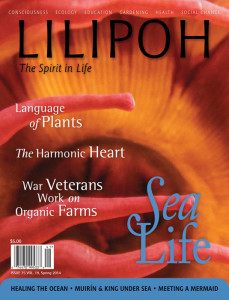Spring 2014, Issue #75: Editor’s Note
 Dear Readers,
Dear Readers,
After living in bucolic land-locked Kentucky for more than twenty years, my family and I traveled to an island off the coast of Washington State with the thought of making a move. During this first visit to the town where we have now lived for three years, I stood overlooking the salt water passage which borders the island’s eastern side and saw a gray whale spout in the distance. A woman and her daughters joined us on the viewing platform, and we immediately recognized each other! It was Sheila, the enrollment director at the Whidbey Island Waldorf school, whom I had known only as a Facebook friend. We introduced ourselves, hugged, and continued to look for more signs of whales. That moment was for me confirmation a that this would be my new home. But that's a story for another time.
After this chance encounter, I learned that 22,000 gray whales migrate from Baja to Alaska each spring. Of those, 200 make a detour from the Pacific route and come inland to the waters of Salish Sea where they dine on ghost shrimp in the shallow sandbars close to shore. In addition to the migrating grays, there is a population of about eighty resident orca whales who live in and around these waters. A local non-profit called the Orca Network monitors orca activity and offers an online platform where people can share the news when they spot whales. (Director Howard Garrett is featured in the documentary Blackfish. If you have not seen this film, please do.) Last summer, sitting at my computer, I happened to notice a message that a large pod of about thirty orcas were swimming through the passage a few blocks from our home. It was a glorious sunny day, and feeling slightly caught up with my work, I dropped what I was doing, hopped in the car, and drove the ten minutes to the ferry terminal. I anticipated that the whales should be coming around the tip of the island, and that I could spot them at this point. Two or three other whale watchers were already there, and together, we spent twenty minutes scanning the still blue water. Finally, here they came, each up to thirty feet in length—in groups of twos, threes, or more—graceful and sleek, coming up to the surface to spout, breathe, and spyhop. The procession lasted about forty-five minutes.
I looked at the time on my phone and saw I had missed my group meditation, but it didn't matter; I felt like I'd just been to church.
What was it about this experience that left me feeling open and expanded, as if the world made sense and anything was possible? I suppose it was the chance to have a fleeting connection with free, wild beings in a setting of such natural beauty. Back at work, back in our amazing human-made world, I am back in my focused mind, which tends to default to limiting outlooks. I keep this photo of the orca whale by my desk, as a reminder to carry that sense of spaciousness, awe, and wonder with me.
Christy Korrow, Editor
